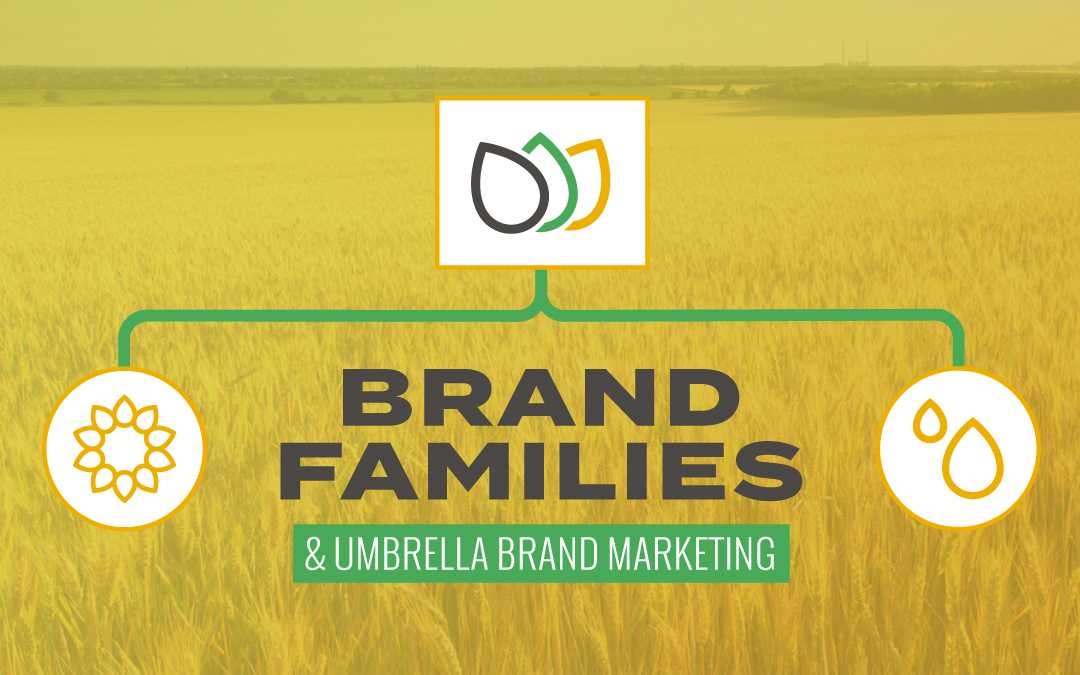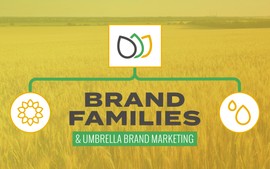Craft Your Umbrella Branding to Define Your Company & Product Family
When we think of umbrella branding, it’s easy to recall a cast of logos, but a brand is much more than just that. When your brand, or brand family, is crafted well and maintained consistently, it helps to define your company or product, both adding to its overall value and distinguishing it in the market.
For the purposes of this blog, let’s think of branding as the strategy behind the choices a company or organization makes that affect their audience’s perception of them, their products, and their services. With a retail store, for instance, branding could include the brand architecture, the lighting, the color of the walls, the feel of a menu, the attire of the employees, and more—even the scent associated with that space—and we haven’t yet begun to describe the product itself!
All of these factors contribute to shaping the way people experience the brand and how they feel about it, whether consciously or not. For many digital brands, the experience is most clearly represented on a website, but it’s also reflected in their social media presence, reviews that live online, the emails they send, sponsorships they have, and yes, even third party organizations, like payment processors, can help shape a customer’s experience. All of these factors contribute to a perception or a belief about that brand.
So why examine all of this? In developing brands, we are able to make small and powerful decisions about each of these aspects, ultimately helping convince customers to buy in to what a brand means and stands for. If we fail to curate a brand… well, it can come off as small-time, inexperienced, or worse yet, scammy — inadvertently cultivating an almost subconscious skepticism about the brand itself. The more consistent a brand is, the more trustworthy it feels to the outside world.
Our Brand Specialist, Brian, answers some FAQs about umbrella brand families and umbrella branding strategies.
Q: What are the benefits of strong, intentional branding as it relates to effectively marketing a product or service?
A: As touched on before, well-crafted and intentional brand elements create a feeling perceived by outsiders about a brand. Every element– from typefaces selected to colors and graphics and copy– can be used in harmony to evoke a feeling in those who encounter said brand. When executed well and consistently, this branding can create a sense of confidence in your products or services and an overall sense of trust for those who partner with or might partner with your company or organization.
Q: What is a brand family?
A: Brands are sometimes connected. Toyota makes Lexus cars, for example. Lowes carries Martha Stewart paints. Viacom owns MTV, Comedy Central, and Nickelodeon. Each of these groups is called a brand family. From our client list, the good folks over at Pebble Isle Marina run a restaurant on-location called Grey Heron Grill. The same group also owns Cane Creek Campground and Marina. These three brands are part of a brand family.
Q: What is a parent brand?
A: A parent brand is the group that owns a subsidiary brand or brands. With the Viacom example, the parent brand is Viacom, and its family of individual brands includes many, many TV networks and other assets. Riverworks Marketing recently had the opportunity to work with Moore Seed & Grain Farms, which is a parent brand over two lines of products. The farm is the parent brand that owns and runs Resaca Feeds (livestock feeds) and Resaca Products (a collection of various types of plant-based oils). We’ll touch more on this later if you read on.
Q: How does operating under umbrella branding affect brand awareness?
A: Brands handle their connections differently. Sometimes no connection is signified; sometimes, it’s heavily relied upon. Gap, Inc., owns Old Navy, but most day-to-day customers don’t notice any connection from one single brand to another. The two brands generally seem to operate autonomously. On the other hand, when a key member of a popular band starts a side project, the side project is often marketed alongside the name of the already-popular musician in order to lend legitimacy to the new project and quickly garner a fan base. This method for audience-building or piggybacking is a great way to get engaged fans (customers) of a successful project to buy into a second project. Whether brands are strongly or loosely connected and how that connection is explained to audiences can help shape the outcomes for those brands.
Q: What are some of the key advantages to developing family brands?
A: When a parent brand has shaped itself well over time and begun to grow its customer base, a high level of trust in that brand generally follows. That trust can be transferred down to another brand and aid in its progress when the second brand successfully aligns itself with the already known-and-trusted brand. Let’s think about it in a concrete example. If you’re a Chattanooga local, you’ve no doubt heard of Public House restaurant. After their decade in business in downtown Chattanooga, if you were to find out that the same people own Il Primo, the high-end Italian restaurant, you might assume there’s a certain level of quality, professionalism, and deliciousness you can expect solely because of its connection to Public House. Sharing brand perception is one of the main advantages of umbrella branding and aligning brands.
From a business-owner’s perspective, there are other benefits as well. These example restaurants may be able to share some suppliers, vendors, tax numbers, and other aspects. Depending on the business, employees might even be able to hop from company to company when there’s a staffing need. The long and short of it is that this relationship between connected brands offers up a wealth of cross-promotional opportunities.
Q: In what situations might there be a need to implement umbrella branding?
A: When a company develops a new product that doesn’t quite go together with an existing product under one brand, it can be a good idea to brand them a bit differently. An organic lotion and a kids’ shampoo might be made by the same manufacturer, but they’ll need to be taken to market in ways that capture the audience differently. The organic lotion might need a more muted and earthy vibe, while the kids’ brand might be more colorful and fun. Perhaps the manufacturer is a well-known and highly trusted name, and in that case it would be helpful to be clear that each product is put out by the parent company, even if their brands are different.
Q: What family brand has the Riverworks team helped develop, and what was the strategy for creating micro brand identities?
A: When Moore Seed and Grain Farms approached Riverworks about branding their new feed product, we quickly understood the benefit of a sunflower-based feed and were eager to help them take it to market effectively. Having an established farm, we asked how they’ve promoted the farm and any other products in the past. The farm, it seemed, didn’t have any real logo or look-and-feel, but did have the trust of their customers, so we wanted to make sure it was apparent that the feed was connected directly to the farm that created it. They also had another product line under their umbrella— a series of plant-derived oil products. We quickly realized they were a prime candidate for a new overall brand system that clearly set the farm as the parent brand and the collections of feeds and oils as product lines, or child brands, produced under their umbrella. So we pitched it, and needless to say, we got the gig. Check out some of the work we did for them below.
We began with the logo, a very good place to start, and felt something simple and iconic was in order. Each of the farm’s 3 branches are symbolized by shapes that are indicative of the 3 phases of a plant’s growth: from planting (seed), to germination (leaf), to flowering (petal).
The product lines have their own meanings. The feeds logo is indicative of a rising sun, or sunflower blossom, since sunflower seeds are a main ingredient in their feeds. The products line is a collection of various types of oils, so a pair of seed or flower petal shapes are used in a vertical orientation to become oil droplets.
The brand family is cohesive because of the commonalities across each logo (fonts, colors and shape elements), while the main farm logo subtly differentiates itself with the use of more varied typefaces and the implementation of green as a tertiary color.
The logos were then extrapolated out across a variety of media including print ads, packaging, and more. You can see the rest of the work we did for them in our portfolio.





